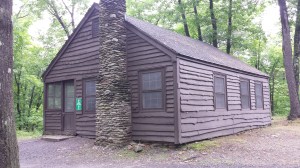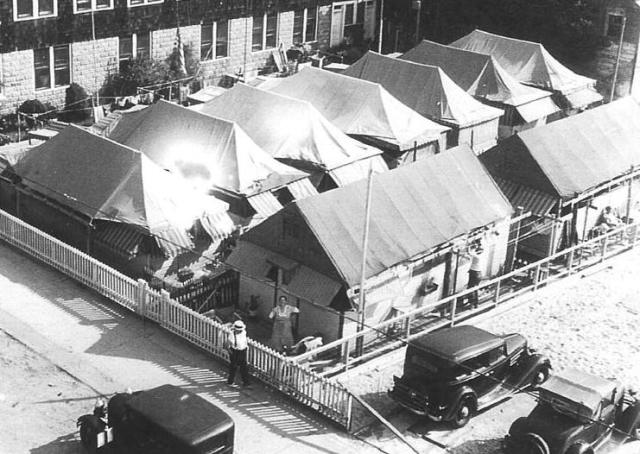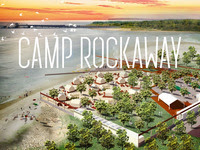9/4/14 UPDATE: Camp Rockaway achieved its Kickstarter funding and will be showing off a model tent on Saturday, September 6, 2014, from noon to 5 p.m., at Beach 92 and Holland Avenue in Rockaway Beach. The public is invited to this “Open Tent” event, to see what is planned and ask questions. Thanks to all the backers who helped fund the project on Kickstarter!
Ahh, Camp Rockaway! The first tent camping proposed for the Rockaway peninsula in over 75 years has taken off on Kickstarter.com. The blogosphere has been chattering since the campaign was launched by sponsor Kent Johnson in mid-May.
The June 18 cutoff date is looming, and the project has achieved about 2/3 of its funding goal, so it certainly seems like an exciting and promising prospect in the making.
I have supported the idea of Camp Rockaway since Johnson first contacted me about it in February, and I applaud him and his partners in this venture for their careful research, trend-spotting, and willingness to take a risk on something that could really amp up local tourism. After all, glamping (slang for “glamorous camping”) is all the rage right now.

You can’t surf at Columbia County’s Lake Taghkanic State Park, but you can boat, swim, and stay overnight in a rustic 2-bedroom cabin that rents for a little over $100 per night.
Last summer, New York state parks introduced yurts (large, circular platform tents with beds and other furnishings inside), and they have been popular in California and Pennsylvania parks for awhile. There are a number of well-reviewed privately owned glamping sites in the Adirondacks and the Catskills. Rates in New York run from about $75 to $200 per night, depending on the amenities. You can’t do much better at Motel 6.
One misconception should be corrected. Camping in Rockaway is not illegal, as asserted by some critics of the Camp Rockaway concept. There is a rule prohibiting camping in New York City parks, but both federal and state parks in New York have camping facilities, and private landowners may do as they wish. I’ve slept under the stars in the Rockaways twice—on the grass in Riis Park during the Relay for Life cancer fundraisers, and in my front yard in Belle Harbor when the lights (and air conditioning) blacked out in the entire city on that muggy night of August 14, 2003. It’s kind of cool to live in a city neighborhood where sleeping outdoors in your yard or local park is even an option.

The Knights of Columbus have always anchored the all-night horseshoes tourney at the Relay for Life cancer fundraiser, Rockaway’s annual group tent camping event at Riis Park.
The original tent camping on the Rockaway peninsula existed from about 1900 to the late 1920’s, when bungalows began to ascend in popularity. These sites were all privately owned, but the owners eventually lost their tent sites when the areas near the beachfront were taken over by NYC Parks Department in the 1920’s and 1930’s. A few rows of tents remained at Beach 98 Street until the late 1930’s, hemmed in by the boardwalk.
Today, there’s one camping area set aside in Gateway National Recreation Area’s Floyd Bennett Field in Brooklyn, but it’s definitely not a “glamp site,” like the planned Camp Rockaway. No tent platforms, queen-size beds, or hot brewed coffee in the mornings at Floyd Bennett. In fact, even having food with you is risky. Urban legend has it that the ravenous raccoons have learned how to undo tent zippers…
I come from a long-time camping family, and can attest that bugs and risky weather come with the territory. Historically, the entire bayfront from Mott’s Point to Hammels Landing was marshland, later filled in to build homes and businesses. Standing water can lead to breeding insects. The location for Camp Rockaway needs to be carefully selected and landscaped, to alleviate this problem. But don’t forget, the idea of camping is to get close to nature and create long-time memories. You’ve gotta’ embrace it!
The weather will be another challenge. One online commentator remembered that the federal park service tried to establish an oceanfront tent campground at Ft. Tilden in the 1980’s, and it was plagued by problems with wind. These days, the rangers build a campfire on the beach at Riis Park on the three major summer holiday weekends, and invite participants to toast marshmallows and sing along. Much more manageable, as lawn chairs are the only potential windborne projectiles to deal with.
And of course, there’s the question of security at any ‘glamping’ site that attracts iphone toting, upper-middle-class tourists adventurous enough to sleep outdoors. The plans for the camp wisely include fences and a security patrol.
I wish all the best to Kent Johnson in his quest to identify a site for Camp Rockaway, get plans and permits approved, and open the gates for business next summer. We need more places that welcome overnight tourists, even if the occupants won’t exactly be sleeping under the stars. If you’d like to help support and fund this intriguing venture, please visit https://www.kickstarter.com/projects/651502646/camp-rockaway.

National Park Service ranger Ricky, surrounded by a bevy of marshmallow-toasting gals at the Riis Park campfire.
Text copyright 2014 Vivian R. Carter. Vintage tent photo courtesy of the Auer family. Camp Rockaway image courtesy Kent Johnson. Last photo in post, courtesy Wendy Armenio. Remaining photos copyright 2010 Vivian R. Carter.





Interesting to hear about the rockaways’ camping past and possible future!I also have a question for you: you said that although camping is prohibited in NYC parks, that is not necessarily the case with federal and state parks in New York. Do you know if it is illegal to camp on the sand of either Ft. Tilden or Jacob Riis Park? I’d like to do it, but don’t want to get fined. Thanks!
As there IS a camping site available to the public at Gateway’s Floyd Bennett Field in Brooklyn, which one must apply to use, it is probably unauthorized to camp anywhere else within the local Gateway unit. I’m not sure about the New Jersey portion of Gateway. The only way to know for sure is to research it. Here’s a link to reserve the Gateway campsite at Floyd Bennett, and when you scroll down there is a tab citing the federal regulations for your reading pleasure! Good luck… http://www.reserveamerica.com/camping/camp-gateway/r/campgroundDetails.do?contractCode=NRSO&parkId=72324